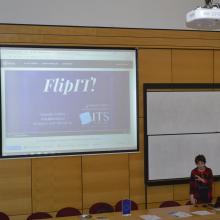Flip IT! – Flipped Classroom in the European Vocational Education
Flip IT! – Flipped Classroom in the European Vocational Education

Recent literature reveals that the full potential of ICT is often not realised in formal education and that “only a few innovative projects manage to survive beyond the early adopter stage and become fully embedded in educational practice.” (S. Bocconi, P. G. Kampylis, Y. Punie, 2012). It is in this context that the “FlipIT” project was conceived; a research project with the aim of integrating the “flipped classroom” method into the pedagogical practice of the VET schools and training centers in the partner countries across Europe. The long-term aim of the project is to improve the quality of vocational education and to engage a movement towards work-based, collaborative and problem-oriented learning/teaching by utilising the pedagogical potential of ICT tools.
The Institute for Prospective Technological Studies of the European Commission's Joint Research Centre (JRC-IPTS) started the “Creative Classroom Programme” in 2012, in line with the flagships’ initiatives of the Europa 2020 strategy. This particular initiative aims to provide a better understanding of ICT-enabled innovation in formal and adult education and to promote the effective use of ICT in modernising pedagogical methods. Within this theme, the “Creative Classroom Lab” was developed by the European Schoolnet in 2013 ( http://creative.eun.org), using the methodology of “Flipped Classroom - FC” The project was piloted across Europe.
Teachers who have experienced the flipped classroom approach have explained how the method increases the interaction between students and teachers emphasising how ‘the teacher is not the sage on the stage, but the "guide on the side"!’. The final conclusion of a five month long pedagogical experiment in the Czech Republic was that the performance of students in mathematics was significantly higher in the student group where FC methods was introduced.[1]
We are convinced that “flipping the classroom” would be especially beneficial for the vocational education sector, where the schools are facing the challenge to meet the needs of the ever-changing labor market. The speed of technological evolution makes it almost impossible to provide the vocational schools with traditional textbooks in time. Preparing learning materials for the students, the teachers have to take into account the huge amount of information available on the Internet. How then can teachers use this concept of “always being connected” to enhance the student experience and student learning? How can they exceed the limits of Power Point presentations in the classroom? What ICT tools are the most effective for supporting enhancing teaching and learning and in particular the Flipped model of learning? The “Flip IT!” consortium would like not only to answer these questions, but to also address teacher’s challenges in a practical way; we believe that teachers are the main actors who can drive the change.
Objectives
- Review the theoretical studies and pedagogical experiences on Flipped Classroom method
- Carry out a needs-analysis by involving the teachers of the partner countries
- Elaborate the “Flipped Classroom Methodology” (textbook, curricula, online training for VET teachers)
- Pilot online course in the partner countries by involving VET teachers
- Validate the results in VET schools by involving students
Primary target group: VET teachers
Secondary target group: VET students
The proposal was submitted by iTStudy Hungary Educational and Research Centre Web: Web: http://www.itstudy.hu
Phone: 28-430 695
Project manager: Mária Hartyányi, e-mail: maria.hartyanyi@itstudy.hu
Project administrator: Judit Mezei, e-mail: judit.mezei@itstudy.hu
Consortium
The consortium involves 10 partners from five European countries. We invited two HE institutes from Spain, Czech Republic, who will provide the theoretical background to the developments by transferring the results of their former research on the flipped classroom methodology. The target institutes - primary beneficiaries of the project results - are represented by three secondary vocational schools, and a vocational high school from Hungary and a large adult educational institute from Spain delivering vocational trainings for adults. Finally we have invited HE institutes from Ireland & United Kingdom provide expertise in e-learning design and development for online courses.
[1] “After evaluating the long term pedagogical experiment we can conclude, that there was significant difference in achievement (evaluated based on post-test) between pupils of experimental and control groups in the selected thematic unit of mathematics. Flipped classroom method, when students are studying a new educational material using educational animated videos, did significantly affect academic performance of students. Creative videos were evaluated positively. We assumed that the new method of teaching pupils interested, especially because the use of modern technology. Which was confirmed.” (Špilka R., Maněnová M., 2014)
Bibliography
S. Bocconi, P. G. Kampylis, Y. Punie (2012): Innovating Learning: Key Elements for Developing Creative Classrooms in Europe, European Commission, Joint Research Centre Institute for Prospective Technological Studies.
Špilka R., Maněnová M., Flipped classroom, web-based teaching method analysis focused on academic performance, Communications, Circuits and Educational Technologies Conference, Prague, April 2014. ISBN: 978-1-61804-231-6
V. Thompson: Evidence of impact of 1:1 access to tablet computers in the classroom, Creative Classrooms Lab, 2013. eLearning: It’s Time for a Reboot (Carol Leaman, WIRED, 24 June 2013.)
Chatti, M. A.; Jarke, M.; Frosch-Wilke, D. (2007): The future of e-Learning: a shift to knowledge net-working and social software, PROLEARN Whitepaper, 2007.
M. Leicht R., E. Zappe S., I. Messner J., Litzinger, T.: Employing the classroom flip to move lecture out of the classroom, Journal of Applications and Practices in Engineering Education, 3(1), 19-31, 2012.
What is the Flipped Classroom model, and how to use it? (CCL GUIDE: LEARNING STORY FLIPPED CLASSSROOM), University of Minho, Portugal, 2013.













